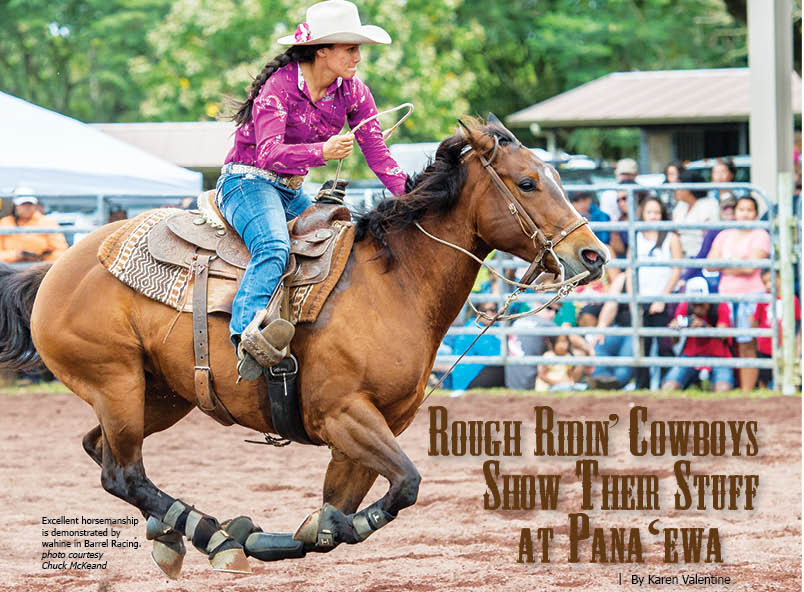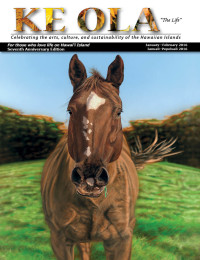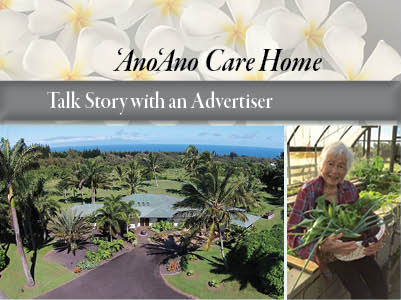
Rough Ridin’ Cowboys Show Their Stuff at Pana‘ewa
 Get ready for some rough ridin’, hoof poundin’, fur flyin’, cowboy rockin’ excitement as some of the island’s top contenders don boots, hats, and spurs to thrill the crowd at the 24th annual Panaewa Stampede Rodeo on February 13 and 14.
Get ready for some rough ridin’, hoof poundin’, fur flyin’, cowboy rockin’ excitement as some of the island’s top contenders don boots, hats, and spurs to thrill the crowd at the 24th annual Panaewa Stampede Rodeo on February 13 and 14.
The Panaewa Stampede in Hilo is one of five annual rodeos on Hawai‘i Island—more rodeo events than any other island—as we celebrate our island’s paniolo culture, still alive and kicking after some 300 years since the first cattle landed as a gift to King Kamehameha the Great in 1798.
The Hawaiian cowboy, or paniolo, was born shortly after that to tame the wild and wooly land-marauding animals. Trained by Hispanic cowboys—vaqueros— from the mainland, the name paniolo (derived from Español), was adopted. By nature, paniolo like to test their skills against one another. They did it first out on the range and then in the arena after Buffalo Bill Cody started the circuit with his Wild West Shows in 1882.

As described in the book American Rodeo: From Buffalo Bill to Big Business: “Cowboys from the various ranches would pit their skills against one another, encouraged by the boss-rancher, who would award a prize (a saddle or a suit of clothes) to the hired hand who made the best showing….Long before rodeo became an organized sport and the participants had virtually unionized, there was such a character as the rodeo cowboy. The rodeo cowboy and wild-west-show performers of that era have been described as ‘mostly open-air delinquents, Civil War draft dodgers and out-and-out renegades,’ who would intersperse their riding and roping with drinking, fighting, and the wrecking of saloons and then repeat the performance in the next town on which they descended…. Cheyenne, Wyoming, beginning in 1897, played host to the largest rodeo in North America, the annual Frontier Days.”
In 1908, Eben “Rawhide Ben” Low, owner and manager of Pu‘uwa‘awa‘a Ranch on Hawai‘i Island, sent three of his top men—Ikua Purdy, Archie Ka‘au‘a, and Jack Low—to the competition. After entering the arena in Cheyenne wearing cowboy hats with flower lei, the paniolo proceeded to show the American cowboys what the Hawaiians could do. Ikua Purdy walked away with top honors in steer-roping and eventual induction into the National Rodeo Cowboy Hall of Fame.
Honoka‘a was the first to host a rodeo on Hawai‘i Island 60 years ago, followed soon after by Waimea, Hōnaunau, Hilo, and Ka‘ū.
In Hilo, the rodeo grew out of the horseracing scene, which enjoyed huge popularity during the Monarchy era at Ho‘olulu Racetrack and Grandstand, located where Hilo’s Edith Kanaka‘ole Stadium, Afook-Chinen Auditorium, and Aquatic Center are today. All equestrian activities were moved to Pana‘ewa in a land exchange by the county of Hawai‘i in 1973, creating the Pana‘ewa Equestrian Center.
The sporting scene was revived there by the Hawai‘i Horse Owners Association, which took on the task of transforming the site in 1993 and becoming its caretakers.
Al Cabral, charter member and president of the association since 1994, says, “In essence, in my opinion, it was a bad exchange. The land there [at Ho‘olulu] was designated by the Queen for horse racing.”
“The Horse Owners Association was created to do the rodeo,” says Al, who was born and raised in the Hilo area and is now retired from HELCO after a 27-year career. “At the beginning, our club also sponsored some horse races, the first one being in conjunction with the Merrie Monarch Festival. We had about 5,000 people here; it was fantastic. Eventually, the guys just got tired of the effort to get the horses ready for racing.”
Rodeo became the club’s main function, and this year will be its 24th annual event.
The rodeo arena sits on about 80–100 acres in a rainforest, also occupied by Pana‘ewa Rainforest Zoo, so clearing the grounds and maintenance has been a big task, he says. However, with major donations of time and materials, the club has made a rodeo facility that draws compliments from competitors. The red cinder base is solid and even when it rains, the arena drains quickly and retains its surface.
“We want to be the best rodeo. It’s not the biggest, but it’s the best in my opinion,” Al contends. “We always work to put on a good show. Our goal is to have spectators jumping off their seats and come back the next year.”
Since this ranching island is rodeo central for Hawai‘i, a lot of the contestants are from here and do the island circuit. It’s often a family tradition, with keiki, wahine, and dad all participating.
“We do funding for keiki around here. We like to keep them involved, and we’ve seen kids grow up in the system and go on to compete elsewhere. Now we have three or four competing as pros on the mainland. Way back, we had working cowboys on the island and the ranches would come. Nowadays we have competitors who go to the different rodeos around the island, but they have other jobs and do this on weekends. They just love to rope and ride,” says Al.
The rodeo website describes the Panaewa Stampede Rodeo: “This large and diverse rodeo features team roping, barrel racing, bronc riding and bull riding. In addition there are special events done only in Hawai‘i. Cowboys and cowgirls will compete in double mugging and po‘o wai u (capture of wild cattle) just like our forefathers did in the early paniolo days of old Hawai‘i.”
Keiki will compete in “mutton busting” (bronco busting on sheep), roping, barrel racing, and junior bull riding. Each year a young cowgirl is named rodeo queen.
“I just love seeing a kid getting in there and giving the old timers a run for their money,” says Al.
As with all rodeos, the Panaewa Stampede is an entertaining show. It includes a well-known rodeo clown, JJ Harrison, who teams up here each year with professional announcer Buster Barton, both from the Pacific Northwest. Not only does the clown perform skits and high jinks to keep the keiki and the crowd amused while the crew sets up the next event, but the professional rodeo clown is something of a land-based lifeguard. He skillfully distracts a confused bull while a thrown rider recovers.
No respectable rodeo cowboy gets away without a few bumps and bruises.
“Our organization has insurance that covers the spectators and facility,” says Al, “but the contestants, the cowboys, are not covered. They have to have their own insurance.”
In the popular double mugging event, one contestant on a horse teams up with one on the ground, the “mugger.” After the steer is roped, the mugger has to get hold of the sometimes 900-pound animal and hold on until his partner dismounts. Together, they have to wrestle the steer to the ground and tie up any three legs. The best time wins.
“There’s lots of action; guys get knocked down,” says Al. “We also have wahine calf mugging, with the same team principle and a smaller animal. It’s real popular among our young ladies, and it works out pretty well for the spectators.”
Chute dogging is another event, using six steers and six men. Al says, “We open the gates all at once, and the first cowboy to knock down his steer wins. It’s crazy. People love it!”
In the past, the organization has tried other creative events. “We had chariot races once. The chariots were fabricated from 55-gallon drums with wheels attached. The wheels would fly off and the horses go crazy. We had a guy race a donkey on foot. The donkey wasn’t very fast (more likely not interested) and the guy actually won.”
The organization rents cattle from several local ranches and some of them get used to the routine. “The animals know if they can get in the opposite gate, they’re safe, so they run. We have a veterinarian and also have paramedics on hand,” he says.
“In our show, we average about 150 contestants,” Al continues. New, ADA-compliant metal bleachers and a pavilion that can hold some 2,000 spectators were installed in 2013.
Al’s wife, Nancy Cabral, owner of Day-Lum Properties in Hilo, signs up competitors and handles finance and marketing.
About 60 volunteers help out, some from the American Cancer Society, which receives a donation from the receipts. They collect the money and run concessions. The 4H Club picks up trash and recyclables and maintains the restroom.
“They do a terrific job,” says Al. “At the end of Sunday the place is immaculate. It’s a combination of a lot of people who make this thing happen.”
For the Cabrals, it’s been a family kuleana (responsibility) and a passion. Three of their four boys have competed in rodeo, with one, Cody, age 27, working the pro circuit from his home in Arizona. Son J.C. owns and operates a cattle ranch in Oregon. Son Jeff was one of the top bull riders in the state and won many other events before retiring from the arena. The couple’s oldest son, Todd, a fireman on O‘ahu, says, “The only way I want any kind of beef is on a plate,” according to his dad, who was also once a competitor. Now there are three grandsons and a granddaughter, all waiting to enter the arena some day. ❖
The 24th Annual Panaewa Stampede Rodeo will be held on Saturday and Sunday, February 13–14, 2016, at the Pana‘ewa Equestrian Center, just outside of Hilo by the Zoo. The Rodeo starts at noon on Saturday and at 11am on Sunday. Pre-sale tickets are available at Coldwell Banker Day-Lum Properties for $6 and at the gate on the day of rodeo
for $8.
Contact Hawaii Horse Owners President, Al Cabral: 808.937.1005
Contact writer Karen Valentine
Other Rodeos on Hawai‘i Island
Honoka‘a Western Week, Parade, and 60th Annual Hawai‘i Saddle Club Scholarship Rodeo
The island’s biggest and oldest rodeo event, held in May. 808.775.0888
Ka‘ū 4th of July Rodeo
Ka‘ū Roping and Riding Association puts on this annual event
at the Nā‘ālehu Arena grounds. 808.929.9281
Kona Stampede Rodeo
The Kona Roping Club has produced this rodeo since 1964. Held in March at the Hōnaunau Rodeo Arena, recently improved with a new pavilion. 808.896.0363
Parker Ranch 4th of July Rodeo
Independence Day Rodeo held every year on 4th of July weekend at the Parker Ranch Rodeo Arena in Waimea.
Parker Ranch Round-Up Rodeo
Scholarship fundraiser for children of Parker Ranch employees. Held annually in September.


